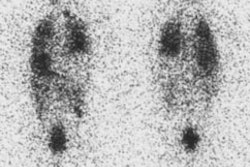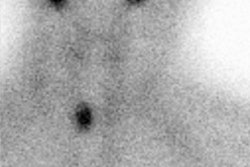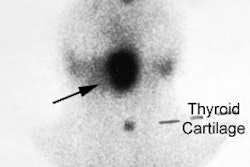J Nucl Med 2001 May;42(5):738-43
Salivary and lacrimal gland dysfunction (sicca syndrome) after radioiodine
therapy.
Solans R, Bosch JA, Galofre P, Porta F, Rosello J, Selva-O'Callagan A, Vilardell
M.
Salivary gland dysfunction has been described in patients undergoing radioiodine
therapy but associated lacrimal gland dysfunction (sicca syndrome) has never
been reported. We conducted a prospective cohort study with follow-up for up to
3 y in a tertiary care university center to determine the prevalence of sicca
syndrome in patients after high-dose radioiodine treatment. METHODS: From
January 1990 to December 1995, all patients undergoing radioiodine therapy (n =
79) with a standard dose of 925 MBq to 18.5 GBq (25-500 mCi) were interviewed
using a standardized questionnaire to determine subjective ocular and oral
dryness and were examined for objective lacrimal and salivary gland dysfunction.
RESULTS: After radioiodine treatment, 32.9% of the patients reported subjective
xerostomia and 25.3% reported subjective xerophthalmia in the first year of
follow-up. Xerostomia persisted to the second year of follow-up in 20.3% of
cases and was still present >3 y after the last dose of radioiodine in 15.2%
of cases. Xerophthalmia persisted to the second year of follow-up in 17.7% of
cases and was still present in the third year of follow-up in 13.9% of cases.
Severe xerostomia occurred in 4 patients. Reduced salivary and lacrimal gland
function was documented in 40 (50.6%) and 14 (17.7%) of the 79 cases,
respectively, in the first year of follow-up. Objective xerostomia persisted in
13.9% of cases to the second year of follow-up and was still present in all
patients >3 y after the last radioiodine application. Keratoconjunctivitis
sicca persisted in 11 patients (13.9%) to the second year of follow-up but was
only present in 6 patients (7.6%) >3 y after the last radioiodine
application. Additionally, 28/79 patients (35.4%) who had a normal salivary
gland scintigraphy previously showed reduced salivary gland function in the
third year of follow-up. No significant dependence on cumulative treatment was
found for objective xerostomia or xerophthalmia, but doses >11.1 GBq (300 mCi)
were related to stage 3 dysfunction on salivary gland scintigraphy. CONCLUSION:
Salivary and lacrimal gland dysfunction (sicca syndrome) is relatively frequent
after radioiodine therapy. In most cases this is a transient side effect, but in
some patients it may persist for a long period or appear late.




